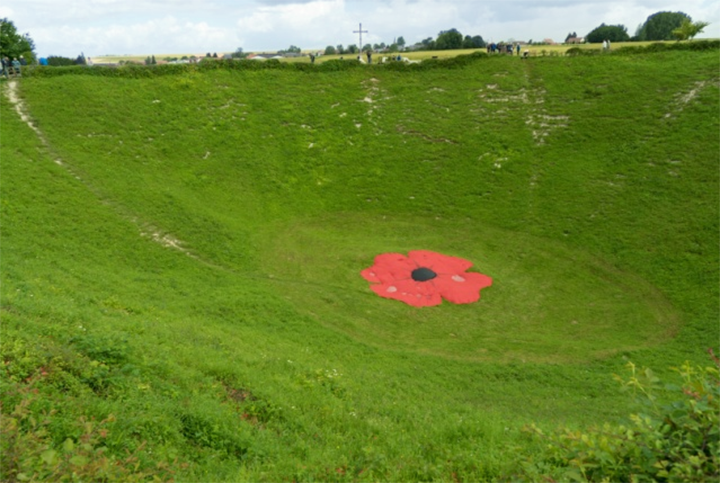
Without doubt the Battle of the Somme was the bloodiest battle fought by Britain and her Allies. Three million soldiers faced each other from their fortified trenches along a thirty-mile length of the Somme valley.
From 1914 until 1916, only small-scale skirmishes had taken place along the Somme but the British line had secured the defences to the important channel ports. France was near to capitulation by early 1916, having lost over 500,000 troops; the Germans had threatened to bleed France white around the area of Verdun. The British government insisted that Douglas Haig, Commander in Chief of British troops, bring forward his planned offensive and thus relieve the French at Verdun and divert German resources by advancing on the line of the Somme.
In 1916, British volunteer troops were ill-trained and ill-prepared to fight the highly skilled German soldiers who fought with superior equipment. The British military command underestimated the German armed forces and its defences. The German trenches, which stretched from the Channel to the Swiss border, were well built, in many places in concrete, and to a depth of three storeys with highly developed communications systems.

Planned to commence on June 28th, the offensive was delayed due to exceptionally bad weather. Following a week-long bombardment consisting of 1.75 million shells the British forces advanced on 1st July 1916, aiming to break the wire entanglements and demoralise the enemy. As the Battle of the Somme unfolded it would claim the lives of 6 of the college alumni.
The signal to commence the offensive was the detonation of 16 large mines along the line, to be timed at 7.30am. Within minutes, troops emerged from their trenches and advanced across muddy fields pitted with shell craters. The whole area was described by troops as a land of foul brown mush, which swallowed everything.

Within the first 24 hours, losses had reached 60,000 with 20,000 dead—the highest ever loss sustained by a British army in a single day. One of our Winchester men died on that first day: Edward Hatcher was Killed in Action (presumed dead) at Gommecourt after going over the top at 7.30am. The battalion had initially taken the first three lines of enemy trenches but were then trapped. A strong counter attack pushed them back to the first (frontline) enemy trench they had taken but they could not retreat further as the enemy artillery were laying down a heavy bombardment in no-man’s land. Eventually a few stragglers managed to make it back to the British frontline trench, but Edward was not among them.
Following initial damage, the progress on the German strongholds became exceptionally slow. By December 1916, the allies had advanced only 7.5 miles. The toll for this advance alone totalled 615,000 wounded, killed or missing in action. Enemy casualties were estimated to be 650,000.
Whilst casualties had been predicted, and preparation made to return the wounded to the U.K., the numbers were overwhelming. Many troops killed at the front were buried near, or close to the where they fell, whilst the wounded were transported to Casualty Clearing Stations and then across the Channel. Two of the college men who were wounded died on route and are buried in Commonwealth War Cemeteries close to the Channel ports. Major Smith (Major was his first name, not rank) was wounded at Hébuterne and died in hospital at Le Tréport, where he was buried. George Springbett was wounded in the Battle of Flers-Courcelette, part of the Battle of the Somme. He was evacuated to one of the seven base hospitals at Etaples where succombed to his injuries and was buried.
Another of the men, 2nd Lieutenant Tom Rowson, fell in September as the Battle of the Somme wore on. There were a number of hellish fights over the major woods on the battlefields. Mametz Wood, Delville Wood and Trones Wood were bitterly fought over but eventually fell to British and Commonwealth forces. Despite attacks over a two month period, the enemy held out in High Wood until 11am on September 15th 1916 when it was taken by 141st (5th London) Brigade. Tom was one of 10 officers of the 1/19th London Regiment (St Pancras) to fall that day.
Our final two casualties during the battle were in September and October. 2nd Lieutenant Francis Chalmers lost his life in the Capture of Gueudecourt on the 25th September (part of the Battle of of Flers-Courcelette where Springbett had been killed a few days earlier) and Dick Pickstone fell nearby at Guedecourt 17 days later in a fresh offensive which was the final action in the Battle of the Somme: the Battle of Transloy.
If any success can be attributed to the battle of the Somme, it was that France’s army was saved from extirpation and continue as a member of the Triple Entente, her troops assisting in the eventual surrender of the Germans, but not before many more millions had perished.

